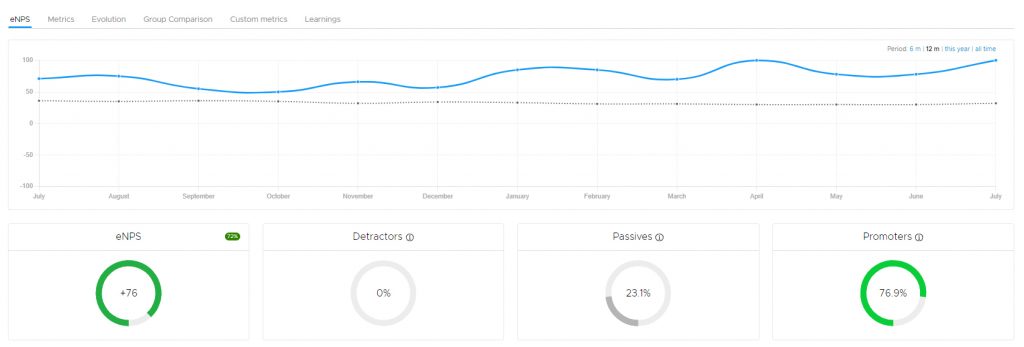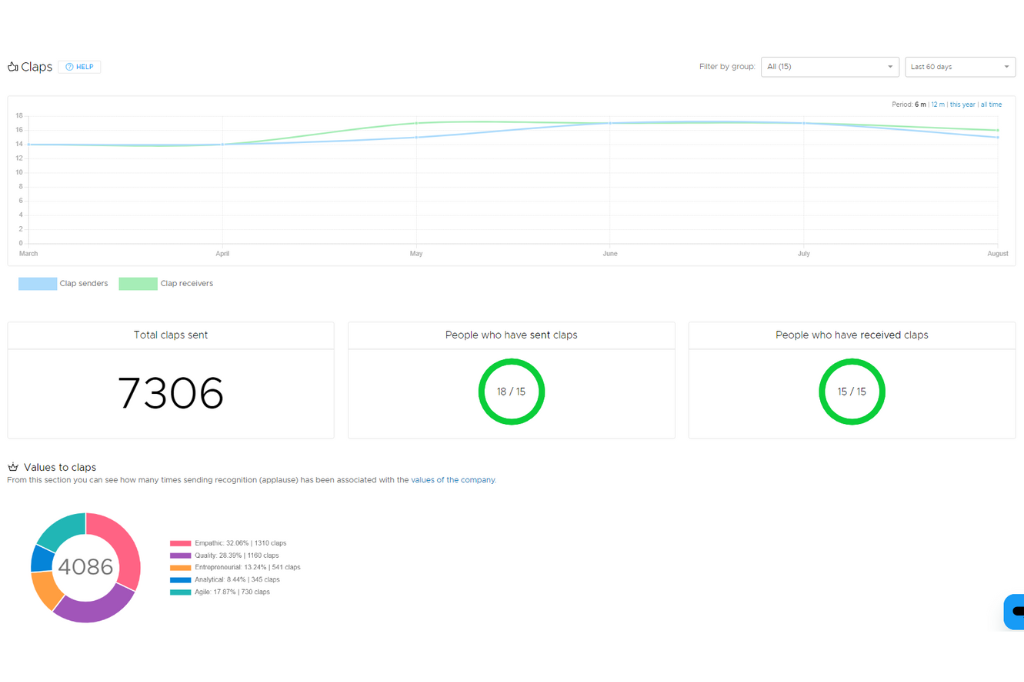Now more than ever, employee engagement is the cornerstone of a company’s success and growth. With each passing year, it becomes more evident that understanding and harnessing the power of employee engagement is no longer an option, but an imperative.
Employee engagement encompasses the dedication, passion and enthusiasm that individuals bring to their roles. In this era of evolving work structures, the importance of employee engagement is now more pronounced than ever.
Through a comprehensive analysis of 25 carefully selected employee engagement statistics, the following words shed light on the multifaceted nature of engagement. In addition, they highlight its influence on productivity, retention, innovation and overall business success. We’ll look at how it also influences the creation of a positive workplace culture that attracts and retains top talent.
Keep in mind that these statistics are not just numbers; they represent the heartbeat of companies navigating a world of change. These employee engagement statistics and trends serve not only to inform, but also to inspire strategies to improve engagement in a company.
- Companies have improved their eNPS to +37.
- 73.9% of employees will nominate their company as the best place to work.
- Disengaged employees cost over $3.400.
- 75.6% of employees consider themselves as company ambassadors.
- 45.9% of employees have higher salary expectations.
- Work affects the personal lives of 25.8% of employees.
- 72% of employees give significant importance to work-life balance when choosing a new job.
- 67.2% of employees attribute the impossibility of achieving a good work-life balance to other colleagues, procedures or even the company culture.
- A good onboarding process increases employee engagement by 33%.
- 93.5% of employees would highly recommend their company services.
- 20% of employees would quit if they couldn’t work remotely.
- 31.3% of employees claim the need for more recognition.
- 58% of employees who work remotely feel more committed to their work.
- 77% of employees confess to having suffered burnout at work.
- 30% of employees confess that they presently find themselves working extended hours compared to pre-pandemic times.
- 32.8% of workers acknowledge having experienced stress either now or in the past due to work-related factors.
- Companies have unnecessary red tape, as 25.3% of employees express.
- A positive company culture reduces turnover by 47%.
- 70% of employee engagement depends on management.
- 26.6% of employees call for improvements in communication.
- 47.7% feel their job tasks align with their skills and interests.
- 27.3% of workers demand greater development opportunities.
- 39.1% of employees say they have no defined career path.
- 42.8% of employees reveal that their company’s mission motivates them.
- Employees driven by a sense of purpose are 12% more productive.
Companies have improved their eNPS to +37
The latest results from Nailted’s Tech Employee Experience Report, reveal a change in the landscape of business dynamics. The statistics revealed in this report highlight a notable increase in eNPS, which now stands at an impressive +37; a substantial rise of 3 points above the previous year’s mark.
This upward trend speaks to a commitment to cultivating an environment that fosters a better employee experience. The eNPS, a metric that measures employee loyalty and satisfaction, is a barometer of the resonance of a company’s culture among its employees. This increase reflects a shift toward a work ecosystem in which employees feel a greater affinity for their roles, teams and the overall mission of the company.
The importance of measuring eNPS is undisputed. It helps so much to define improvement strategies that have a positive impact on people that it has become the most important KPI of employee engagement.
Keep in mind that there are Employee engagement tools such as Nailted that can help you obtain your eNPS.

73.9% of employees will nominate their company as the best place to work
An overwhelming 73.9% of employees are willing to nominate their own company for the prestigious title of “Best Place to Work”. Such a high percentage signifies not only satisfaction, but also a deep sense of pride in their companies.
This employee engagement statistic highlights the bridge between employee satisfaction, engagement and overall workplace climate. It underscores the fact that, beyond salary and other benefits, the quality of company culture, fellowship and sense of purpose has a great influence on employee engagement and motivation.
As the importance of a positive workplace experience gains prominence, a new era is dawning in which companies strive to be promoters not only of thriving businesses, but also of thriving, empowered and satisfied employees.
Disengaged employees cost over $3.400
The cost of having poorly motivated employees can be very high. In fact, disengaged employees cost an additional $3,400 for every $10,000 in salary. Therefore, keeping employees motivated is essential not only for their personal satisfaction, but also for the financial and operational success of the company.
Positive feedback presents a highly effective strategy to inspire and motivate your workforce. This feedback focuses on acknowledging the strengths, aptitudes, and accomplishments of employees. The power of positive feedback initiates a self-reinforcing cycle of ongoing recognition. This phenomenon, often referred to as “a positive feedback loop,” is key in nurturing a work environment that thrives on optimism and growth.
By consistently recognizing the strong points and achievements of your team members, you tap into a motivational wellspring that fuels their drive to excel. Furthermore, this approach creates a ripple effect, instilling a culture of continuous learning. Employees who receive recognition messages are more inclined to invest their skills and energies into their roles, subsequently fostering their personal and professional growth, leading to company success.
75.6% of employees consider themselves as company ambassadors
Employee engagement plays a key role in fostering brand advocacy. Satisfied and fulfilled employees become potent champions of their company’s brand identity. An impressive 75.6% of employees perceive themselves as active ambassadors for their company.
The concept of brand advocacy is a testament to the intertwined relationship between internal satisfaction and external representation. As employees connect on a deeper level with their company’s values and mission, and feel an increment in their satisfaction, they naturally evolve into enthusiastic advocates. This will prompt employees to share their positive experiences organically.
This phenomenon extends beyond typical marketing strategies, as it originates from genuine sentiments and personal investment. It also signifies a great synergy between engaged employees and company success. When employees feel deeply connected to their companies, their enthusiasm permeates interactions with other people, elevating the organization’s reputation.
It’s highly important to act carefully on this, a negative brand advocacy can highly penalize the company reputation, growth and overall success.
45.9% of employees have higher salary expectations
Salary significantly influences employees’ commitment, acting as a fundamental factor in their overall job satisfaction. The financial aspect is considered substantial in the lives of employees, encompassing their aspirations and economic stability. This reality is underscored by the fact that 45.9% of workers believe they deserve a pay rise.
A fair and competitive salary not only reflects the value employees bring to the company, but also underscores a company’s dedication to the well-being and growth of its people. It goes beyond mere monetary transactions; it represents recognition of the critical role employees play in its success.
The link between pay and employee engagement highlights the changing dynamics of employee priorities. Navigating this paradigm shift by aligning compensation strategies with these expectations is not only critical to employee satisfaction. It is essential to establishing a workforce that is motivated, engaged and willing to contribute to the prosperity of the organization.
Work affects the personal lives of 25.8% of employees
The growing necessity of achieving a good work-life balance by employees is far from a mere coincidence. This trend is reflected in compelling statistics, with 72% of workers giving significant importance to work-life balance when choosing a new job.
This factor stands as a key factor of job satisfaction. As a result, it’s no wonder that a substantial 25.8% of employees express that work significantly affects their personal lives.
An even more remarkable figure emerges: 67.2% of employees attribute the impossibility of achieving this balance to other colleagues, procedures or even the company culture.
So, what can organizations do to mitigate this concern? Embracing smart working arrangements, such as flexible working hours, 4 day work week, and the adoption of hybrid or remote work models, has been seen as a powerful approach.
The strategies mentioned above not only enhance employee motivation and engagement, but also reduce stress. By offering employees the option to organize their work around their lives, companies create an environment that values their well-being.
A good onboarding process increases employee engagement by 33%
Carefully designing the onboarding process for new employees offers numerous benefits: rapid initial productivity and assimilation of the company’s mission, vision and values. These are not mere assumptions; the data clearly shows the significant impact of a good onboarding process, which contributes to a remarkable 33% improvement in employee engagement.
However, this concept goes even deeper. Did you know that the first 90 days play a crucial role in fostering long-term employee engagement? They certainly do. Onboarding effectiveness is critical to reducing employee turnover.
A smooth and engaging onboarding experience goes beyond bureaucratic red tape. It lays the foundation for a lasting connection, cultivating a sense of belonging that extends beyond the initial stages of employment.
93.5% of employees would highly recommend their company services
When employees internalize and connect with the company mission, vision and values, they are more likely to recommend the products or services it offers. A significant 93.5% of employees are willing to wholeheartedly recommend their company’s offerings, a clear manifestation of their loyalty and trust in the company.
From a broader perspective, employee recommendations not only validate positive work experiences, but also reflect their gratification to the company and an increased employee engagement. These recommendations shape the external perception of the company, attracting the attention of both potential customers and prospective talent. This positive cycle creates a resonant impact that echoes throughout the organization’s ecosystem.
By fostering a vision-sharing workforce, companies can harness the power of their employees as brand advocates, amplifying their reach and influence while cultivating a positive, inspiring and impactful company culture.
20% of employees would quit if they couldn’t work from home
The reality of remote work has taken firm root. Among those who have experienced its advantages, a significant portion find this new way of working so compelling that returning to traditional in-person roles seems unappealing. In fact, the numbers speak for themselves: 20% of employees would consider leaving their current job if the privileges of remote work were taken away.
This underlines that one of the most important benefits of remote work for a company lies in its role as a talent retention tool. However, the advantages go far beyond this. Remote work simultaneously addresses several challenges: it curbs absenteeism rates, reduces operating costs, helps to cope with stress, increases work-life balance, fosters autonomy and boosts the inclusion of people with disabilities in the workforce.
It is worth noting that 58% of employees who work remotely feel more committed to their work. It goes without saying that telecommuting has transformed the employment landscape.
However, we must keep in mind that beyond its undeniable benefits, this mode of working requires innovative approaches to maintain employee engagement and productivity. For a more in-depth look at these strategies, take a look at this comprehensive guide on hybrid-remote work that will give you the keys to effectively working on employee engagement in remote work.
31.3% of employees claim the need for more recognition
Without question, recognition is the key to employee motivation. The evidence speaks loud and clear: 31.3% of employees surveyed for Nailted Tech Employee Experience Report a compelling need for more frequent employee recognition in their workplaces.
When it comes to recognizing employees’ achievements and hard work, there are a multitude of strategies you can implement. At Nailted, we recommend gamifying the recognition process to really make it a habit in the workplace and create a loop of positive messages.
Don’t forget what we mentioned earlier “make it a habit”. That’s how it will work in the long run to bring real value to your organization. But you can’t just go around asking one by one if they sent and received acknowledgement, can you? Nailted has it figured out through our refined recognition analytics.

77% of employees confess to having suffered burnout at work
77% of employees acknowledge experiencing burnout in their professional lives within the past year. Notably, years after, the impact of burnout has been exacerbated by the pandemic. 30% of employees confess that they presently find themselves working extended hours compared to pre-pandemic times, serving as a clear sign of burnout.
With a data-driven understanding of the issue, companies hold the power to drive real change. By fostering a culture of well-being through targeted wellness initiatives and resources, they forge a path towards a positive and empowered workforce.
The weight of work-induced stress is palpable, with a significant 32.8% of workers acknowledging experiencing stress either currently or in the past due to work-related factors.
Promoting employee well-being isn’t just altruistic, it’s a strategic imperative. When organizations proactively attend to the holistic health of their employees, it not only averts burnout and attrition but also cultivates an environment that breeds resilience, motivation, and enduring commitment.
Companies have unnecessary red tape, as 25.3% of employees express
25.3% of employees express the sentiment that their company has regulations that they deem unnecessary. These findings serve as a signal of unwavering adherence to rigid internal protocols. These procedures, if unchecked, could potentially affect efficiency and adaptability in the work environment, subsequently having a negative impact on the level of employee engagement.
Here we find a great opportunity for change, fostering a workplace culture that thrives on collaboration and dynamic adaptability. We recommend actively involving employees in the crafting of organizational policies, soliciting feedback through employee surveys and communication channels. This collaborative approach ensures that policies align with the workforce and the company’s evolving needs.
Transparency is key in this process. Ensuring that the reason behind policies is well-communicated promotes that employees are more open to accept them, or propose suggestions that better adapt to their needs.
A positive company culture reduces turnover by 47%
The impact of a positive company culture on engaging talent cannot be overstated. A recent research reveals that a strong company culture can lead to a remarkable 47% reduction in employee turnover.
When a company nurtures a culture that cares about its workforce, instills motivation, and cultivates a gratifying work environment, employees are more willing to commit to the organization rather than actively seek a job change.
It is undeniable that a significant turnover rate can have very damaging effects on a company. Therefore, uncovering the variables that contribute to employee turnover is vitally important. Equally important is to continuously measure turnover rate to know its progress over time, allowing a detailed analysis of its evolution.
70% of Employee Engagement depends on management
Fostering a positive relationship between managers and employees increases employee engagement. In the professional environment, the creation of strong bonds between colleagues is key to building a positive company culture that fosters motivation and engagement. In this context, 1:1 meetings and feedback emerges as a solid pillar to strengthen these bonds.
A significant 70% of employee engagement and satisfaction comes directly from the quality of the relationship between managers and subordinates.
Simply put, it is very important to cultivate an environment of constructive, uplifting and positive interactions between team members and leaders. It is essential to share feedback in the right way, and use the right methodologies, to ensure that the information provided is effective and received with receptivity. In this way, companies pave the way for a more engaged and harmonious work environment.
26.6% of employees call for improvements in communication
Employees are demanding greater transparency and quality in the information received from organizations. As well as the opening of channels that allow employees to communicate their needs, concerns and interests.
The feedback that employees can provide is the path that companies can follow to improve the employee experience. It is no mere coincidence that 26.6% of employees believe that organizational communication should be improved.
47.7% feel their job tasks align with their skills and interests
Job satisfaction is a treasure that employees often discover while performing the tasks they enjoy the most. When employees are engaged in activities that truly delight them, the impact on their productivity is remarkable. In fact, 47.7% of employees not only find pleasure in their work tasks, but also feel that these tasks align with their skills, interests and responsibilities.
Nurturing this connection between job satisfaction and task enjoyment requires a strategic approach. An effective strategy to uncover strengths and interests is conducting performance reviews.
When you identify each employee’s unique skills, you can strategically assign them to roles that not only leverage their capabilities, but also make them feel more satisfied. This powerful synergy not only leads to greater productivity, but also contributes substantially to improving the employee experience.
27.3% of workers demand greater development opportunities
The need for growth is a frequent conversation among employees. A sizable 27.3% of workers demand greater development opportunities. In addition, a staggering 39.1% say they have no defined career path.
In the search for a workplace that truly values the well-being of its employees, it is essential to meet their development needs by addressing their growth aspirations. Beyond a salary increase, these people are looking for an enriching environment that fosters their personal and professional skills. The task, therefore, is to create opportunities that allow them to move up to more demanding positions, if they so desire.
A well-crafted career development plan serves as a compass that guides employees to their desired destinations. The mere availability of development opportunities not only broadens their competencies, but expands the horizons of what they can achieve. The ability to skillfully design and implement such a plan is, therefore, a testament to the company’s commitment to the holistic development of its employees.
42.8% of employees reveal that their company’s mission motivates them
The value of a strong corporate mission leads to improvements in employee motivation. A remarkable 42.8% of employees reveal that their company’s mission and values serve as cornerstones of motivation.
A formidable corporate mission assumes the role of a guiding lodestar. It forges an intricate alignment between the individual’s aspirations and the company’s overall goals. As a result, each workday is imbued with a deep sense of purpose and meaning.
But this is not a superficial pursuit. A strong corporate culture is a pillar of distinction for companies. Its value lies not only in cultivating an enjoyable work environment, but in its ability to enhance employee engagement and satisfaction. Keep in mind the importance of this fact, recognizing that satisfied employees, driven by a sense of purpose, are 12% more productive.
The question arises: why put off cultivating a strong corporate culture? The journey begins with defining the company’s mission, vision and values, which serve as the foundation upon which a vibrant, purpose-driven culture thrives.

Discover what really matters
These employee engagement statistics can help you get an overview of the global picture. However, don’t downplay the importance of measuring employee engagement levels in your company, you can do it in 8 simple steps.
Also, keep in mind that an effective way to unravel the dimensions of employee engagement lies in meticulous analysis of the most important metrics, do you have them under control?
You may also consider implementing an employee engagement tool powered by powerful people analytics to automate and simplify this measurement process. Nailted’s people analytics gives you the ability to extract first-hand, real-time data segmented by groups and/or areas of the business that will allow you to make informed decisions.
Always remember, you can’t improve what you don’t measure!










